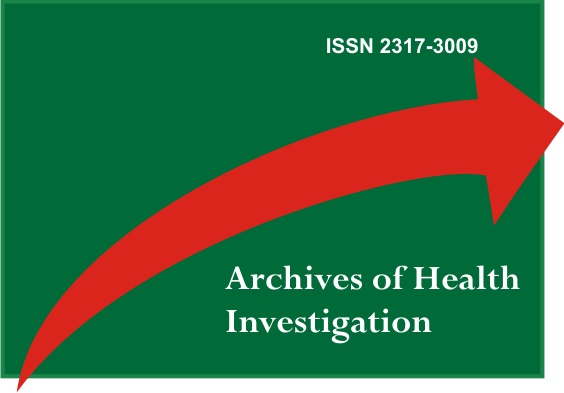The state of art of Artifical Intelligence (AI) in dental radiology: a systematic review
DOI:
https://doi.org/10.21270/archi.v10i7.5069Keywords:
Artificial intelligence, Learning, Machine Learning, RadiologyAbstract
Introduction: Artificial intelligence (AI) is the ability to imitate brain function. It is a technology that uses machine learning, artificial neural networks and deep learning. In addition, they use improved algorithms to “know” resources from a large volume of health data to contribute to clinical activity, providing a faster and more accurate result, thus reducing diagnostic errors. Aim: The aim of this systematic review is to discuss the state of the art in artificial intelligence in Dental Radiology. Material and method: In the search for evidence, the MEDLINE, PubMed, BBO, LILACS, BIREME, Google Scholar, and COCHRANE databases were consulted, using the PICOS strategy. The entire evaluation and selection process was carried out by two independent examiners. Results: 878 articles were found, following the eligibility criteria, the titles and abstracts were analyzed and 778 abstracts were excluded from the study, 10 full texts, and finally 10 studies were included in the work.Conclusion: It was concluded that the results obtained confirm that both deep learning and machine and artificial neural network learning are a precursor field that show encouraging results, mainly for the relevant assistance provided to inexperienced professionals and for providing a more accurate and quick diagnosis. . The artificial intelligence associated with dental radiology shows the optimization of time, precision diagnostic, elaboration of personalized treatments and prediction of treatment effectiveness, characteristics that contribute to better quality of care and, therefore, another aid tool for radiology professionals.
Downloads
References
Yaji A, Prasad S, Pai A. Artificial Intelligence in Dento-Maxillofacial Radiology. Act Scient Dent Scienc. 2018;3(1):116-18.
Khanna SS, Dhaimade PA. Artificial Intelligence: Transforming Dentistry Today. J Ind Basic Ap Med Research. 2017;6(3):161-64.
Schwab KA Quarta revolução industrial. Barcelona: Debate; 2016.
Lobo LC. Artificial Intelligence, the Future of Medicine and Medical Education. Rev Bras Educ Med. 2018;42(3):3-8.
Liew C. The future of radiology augmented with Artificial Intelligence: A strategy for success. Eur J Radiol. 2018;102:152-56.
Paiva OA, Prevedello LM. O potencial impacto da inteligência artificial na radiologia. Radiol Bras. 2017;50(5):V-VI.
Azevedo-Marques PM, Mencattini A, Salmeri R, et al. Medical image analysis and informatics. Boca Raton, FL: CRC Press; 2017.
Doi K. Computer-aided diagnosis in medical imaging: historical review, current status and future potential. Comput Med Imaging Graph. 2007;31:198-211
Aerts HJWL. The potential of radiomic-based phenotyping in precision medicine: a review. JAMA Oncol. 2016;2:1636-42.
Keek SA, Leijenaar RT, Jochems A, et. al. A review on radiomics and the future of theranostics for patient selection in precision medicine. Br J Radiol. 2018;91:20170926
Kalappanavar A, Sneha S, Annigeri RG. Artificial intelligence: A dentist’s perspective - J Med RadiolPathol Surg. 2018;5:2-4.
Kise Y, Ikeda H, Fujii T, Fukuda M, Ariji Y, Fujita H, Katsumata A, Ariji E. Preliminary study on the application of deep learning system to diagnosis of Sjögren's syndrome on CT images. Dentomaxillofac Radiol. 2019;48(6):20190019.
Murata M, Ariji Y, Ohashi Y, Kawai T, Fukuda M, Funakoshi T, Kise Y, Nozawa M, Katsumata A, Fujita H, Ariji E. Deep-learning classification using convolutional neural network for evaluation of maxillary sinusitis on panoramic radiography. Oral Radiol. 2019;35(3):301-7.
Hiraiwa T, Ariji Y, Fukuda M, Kise Y, Nakata K, Katsumata A, Fujita H, Ariji E. A deep-learning artificial intelligence system for assessment of root morphology of the mandibular first molar on panoramic radiography. Dentomaxillofac Radiol. 2019;48(3):20180218.
Lee JH, Kim DH, Jeong SN, Choi SH. Detection and diagnosis of dental caries using a deep learning-based convolutional neural network algorithm. J Dent. 2018: 10.1016/j.jdent. 2018.07.015.
Kim, D.W., Lee, S., Kwon, S, Nam W, Cha IH, Kim HJ. Deep learning-based survival prediction of oral cancer patients. Sci Rep. 2019;9:6994.
Shankarapillai R, Mathur lk, Nair MA, Rai N, Mathur A. Periodontitis Risk Assessment using two artificial Neural Networks-A Pilot Study. Int J Dent Clin. 2010:2(4):36-40
De Tobel J, Radesh P, Vandermeulen D, Thevissen PW. An automated technique to stage lower third molar development on panoramic radiographs for age estimation: a pilot study. J Forensic Odontostomatol. 2017;35(2):42-54.
Jung SK, Kim TW. New approach for the diagnosis of extractions with neural network machine learning. Am J Orthod Dentofacial Orthop. 2016;149(1):127-33.
Jha S, Topol EJ. Information and Artificial Intelligence. Journal of the American College of Radiology.2018;15(3):509-11.
Majumdar B, Sarode SC, Sarode GS, Patil S. Technology: Artificial intelligence. J Brit Dent. 2018;224(12):916.
Marques JR. Inteligência Artificial: vantagens e desvantagens quanto ao seu uso. Portal IBC2017. [Citado 2019 Fev 4]. Disponível em : https://www.ibccoaching.com.br/portal/artigos/inteligencia-artificial-vantagens-desvantagens-quanto-seu-uso/
Khanna SS, Dhaimade P.A. Artificial Intelligence: Transforming Dentistry Today. J Ind Basic Ap Med Research. 2017;6(3):161-64.


